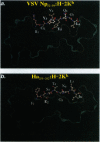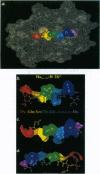Abstract
Cytotoxic T cells recognize mosaic structures consisting of target peptides embedded within self-major histocompatibility complex (MHC) class I molecules. This structure has been described in great detail for several peptide-MHC complexes. In contrast, how T-cell receptors recognize peptide-MHC complexes have been less well characterized. We have used a complete set of singly substituted analogs of a mouse MHC class I, Kk-restricted peptide, influenza hemagglutinin (Ha)255-262, to address the binding specificity of this MHC molecule. Using the same peptide-MHC complexes we determined the fine specificity of two Ha255-262-specific, Kk-restricted T cells, and of a unique antibody, pSAN, specific for the same peptide-MHC complex. Independently, a model of the Ha255-262-Kk complex was generated through homology modeling and molecular mechanics refinement. The functional data and the model corroborated each other showing that peptide residues 1, 3, 4, 6, and 7 were exposed on the MHC surface and recognized by the T cells. Thus, the majority, and perhaps all, of the side chains of the non-primary anchor residues may be available for T-cell recognition, and contribute to the stringent specificity of T cells. A striking similarity between the specificity of the T cells and that of the pSAN antibody was found and most of the peptide residues, which could be recognized by the T cells, could also be recognized by the antibody.
Full text
PDF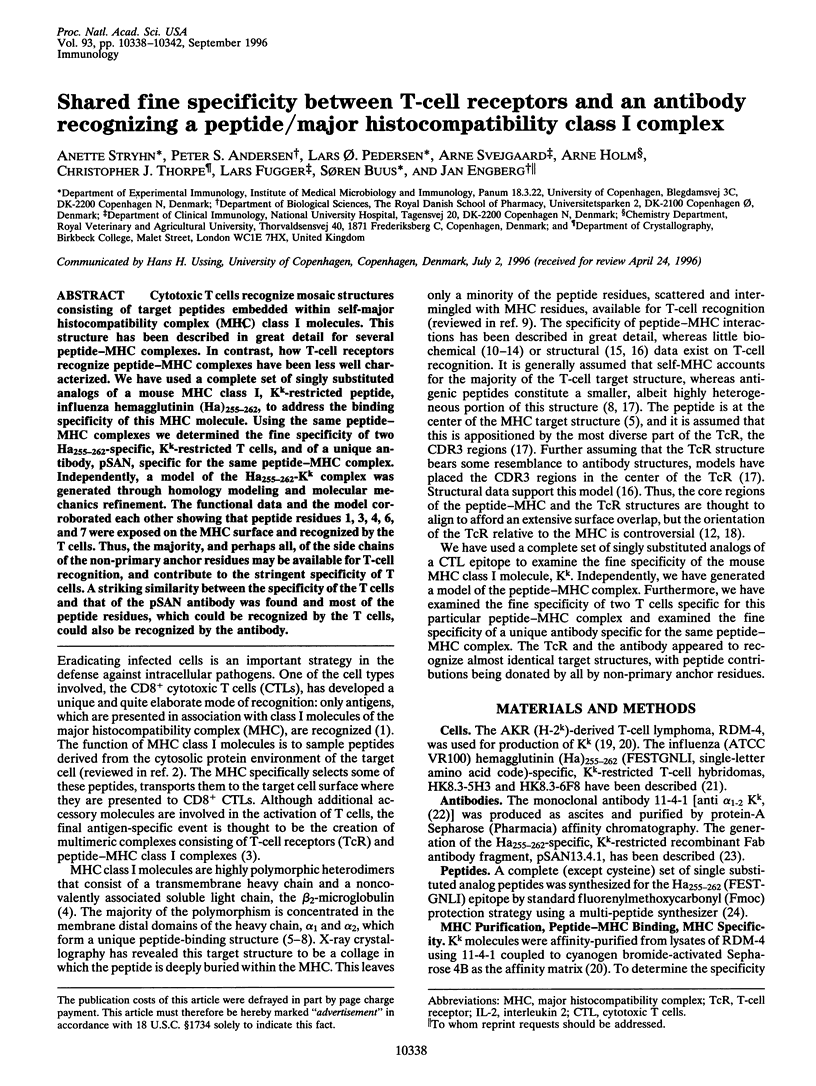
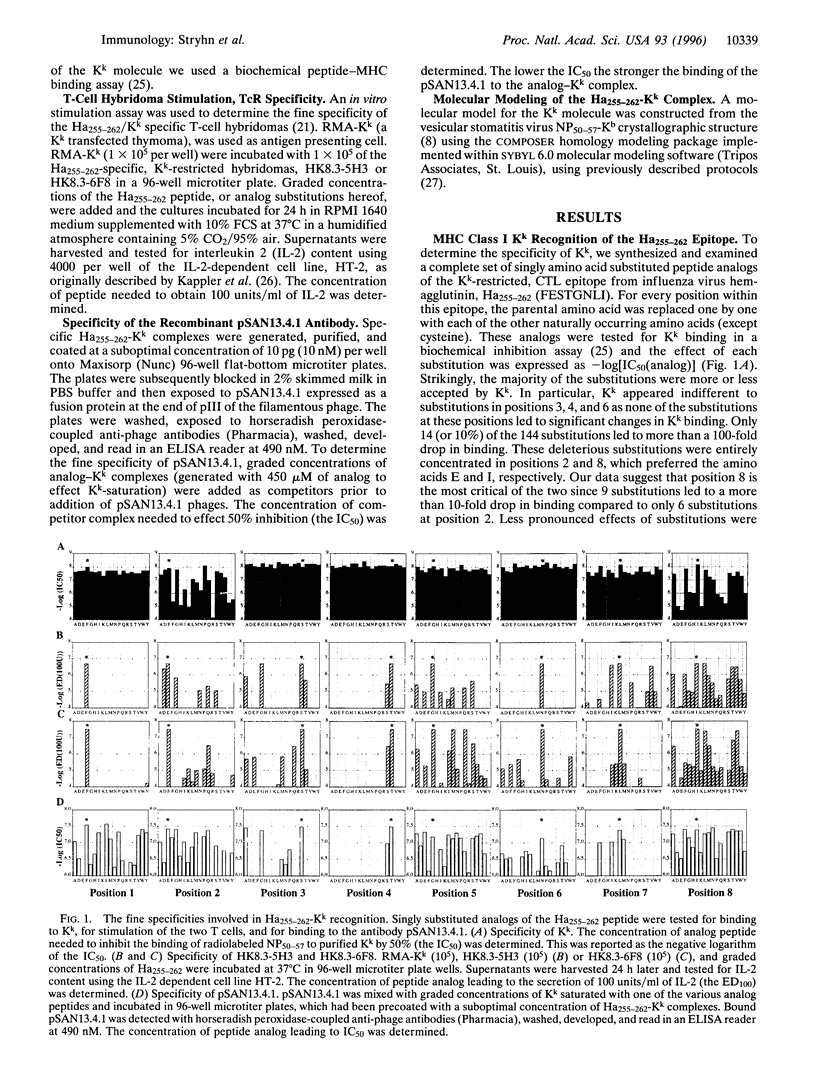
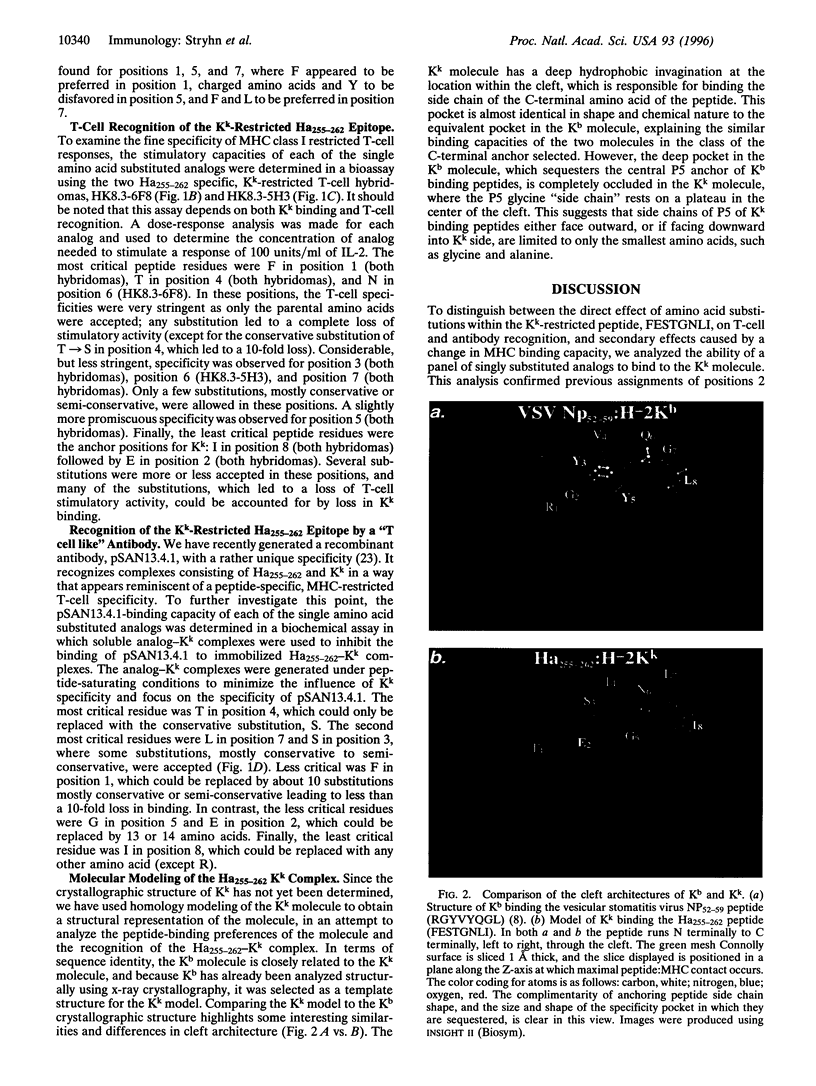
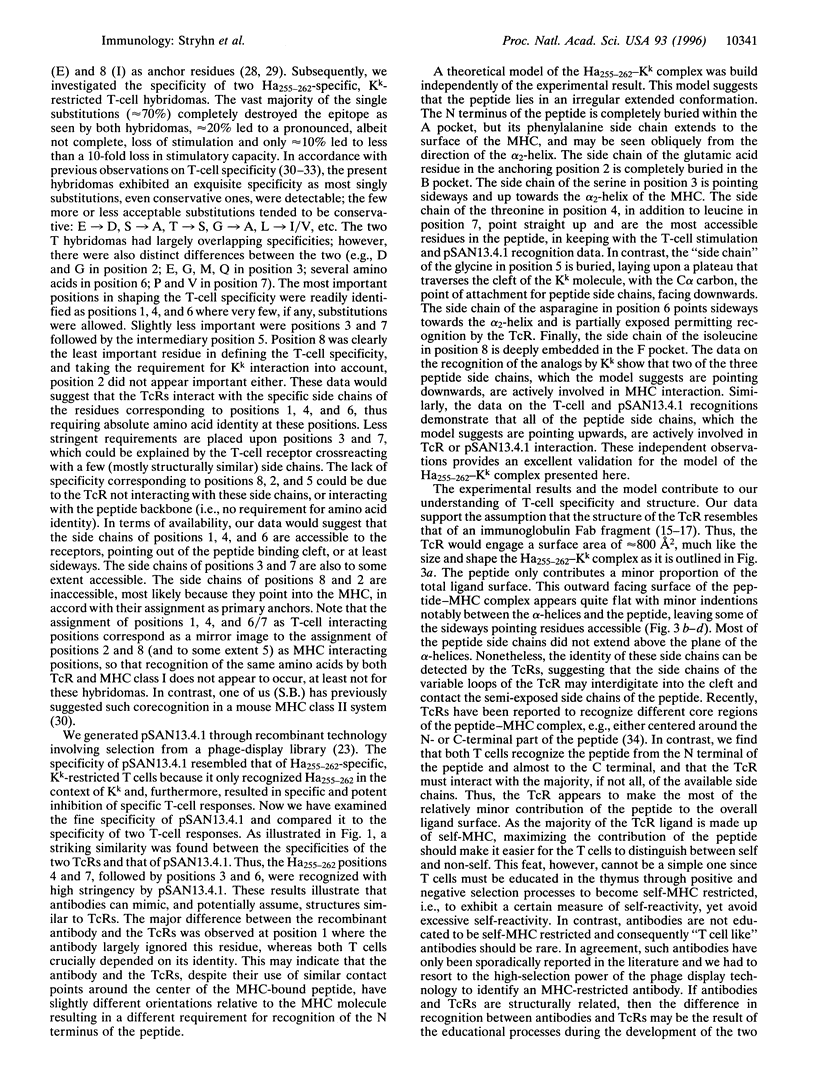
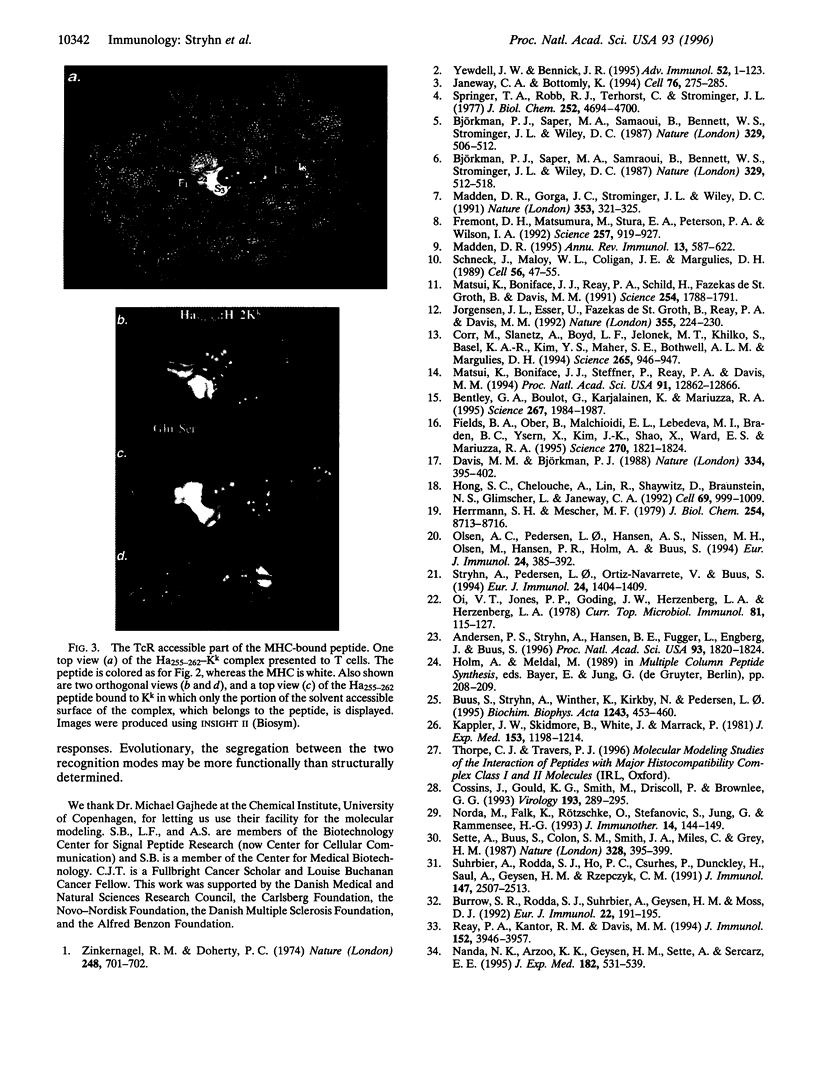
Images in this article
Selected References
These references are in PubMed. This may not be the complete list of references from this article.
- Andersen P. S., Stryhn A., Hansen B. E., Fugger L., Engberg J., Buus S. A recombinant antibody with the antigen-specific, major histocompatibility complex-restricted specificity of T cells. Proc Natl Acad Sci U S A. 1996 Mar 5;93(5):1820–1824. doi: 10.1073/pnas.93.5.1820. [DOI] [PMC free article] [PubMed] [Google Scholar]
- Bentley G. A., Boulot G., Karjalainen K., Mariuzza R. A. Crystal structure of the beta chain of a T cell antigen receptor. Science. 1995 Mar 31;267(5206):1984–1987. doi: 10.1126/science.7701320. [DOI] [PubMed] [Google Scholar]
- Bjorkman P. J., Saper M. A., Samraoui B., Bennett W. S., Strominger J. L., Wiley D. C. Structure of the human class I histocompatibility antigen, HLA-A2. Nature. 1987 Oct 8;329(6139):506–512. doi: 10.1038/329506a0. [DOI] [PubMed] [Google Scholar]
- Bjorkman P. J., Saper M. A., Samraoui B., Bennett W. S., Strominger J. L., Wiley D. C. The foreign antigen binding site and T cell recognition regions of class I histocompatibility antigens. Nature. 1987 Oct 8;329(6139):512–518. doi: 10.1038/329512a0. [DOI] [PubMed] [Google Scholar]
- Burrows S. R., Rodda S. J., Suhrbier A., Geysen H. M., Moss D. J. The specificity of recognition of a cytotoxic T lymphocyte epitope. Eur J Immunol. 1992 Jan;22(1):191–195. doi: 10.1002/eji.1830220128. [DOI] [PubMed] [Google Scholar]
- Buus S., Stryhn A., Winther K., Kirkby N., Pedersen L. O. Receptor-ligand interactions measured by an improved spun column chromatography technique. A high efficiency and high throughput size separation method. Biochim Biophys Acta. 1995 Apr 13;1243(3):453–460. doi: 10.1016/0304-4165(94)00172-t. [DOI] [PubMed] [Google Scholar]
- Corr M., Slanetz A. E., Boyd L. F., Jelonek M. T., Khilko S., al-Ramadi B. K., Kim Y. S., Maher S. E., Bothwell A. L., Margulies D. H. T cell receptor-MHC class I peptide interactions: affinity, kinetics, and specificity. Science. 1994 Aug 12;265(5174):946–949. doi: 10.1126/science.8052850. [DOI] [PubMed] [Google Scholar]
- Cossins J., Gould K. G., Smith M., Driscoll P., Brownlee G. G. Precise prediction of a Kk-restricted cytotoxic T cell epitope in the NS1 protein of influenza virus using an MHC allele-specific motif. Virology. 1993 Mar;193(1):289–295. doi: 10.1006/viro.1993.1124. [DOI] [PubMed] [Google Scholar]
- Davis M. M., Bjorkman P. J. T-cell antigen receptor genes and T-cell recognition. Nature. 1988 Aug 4;334(6181):395–402. doi: 10.1038/334395a0. [DOI] [PubMed] [Google Scholar]
- Fields B. A., Ober B., Malchiodi E. L., Lebedeva M. I., Braden B. C., Ysern X., Kim J. K., Shao X., Ward E. S., Mariuzza R. A. Crystal structure of the V alpha domain of a T cell antigen receptor. Science. 1995 Dec 15;270(5243):1821–1824. doi: 10.1126/science.270.5243.1821. [DOI] [PubMed] [Google Scholar]
- Fremont D. H., Matsumura M., Stura E. A., Peterson P. A., Wilson I. A. Crystal structures of two viral peptides in complex with murine MHC class I H-2Kb. Science. 1992 Aug 14;257(5072):919–927. doi: 10.1126/science.1323877. [DOI] [PubMed] [Google Scholar]
- Herrmann S. H., Mescher M. F. Purification of the H-2Kk molecule of the murine major histocompatibility complex. J Biol Chem. 1979 Sep 25;254(18):8713–8716. [PubMed] [Google Scholar]
- Hong S. C., Chelouche A., Lin R. H., Shaywitz D., Braunstein N. S., Glimcher L., Janeway C. A., Jr An MHC interaction site maps to the amino-terminal half of the T cell receptor alpha chain variable domain. Cell. 1992 Jun 12;69(6):999–1009. doi: 10.1016/0092-8674(92)90618-m. [DOI] [PubMed] [Google Scholar]
- Janeway C. A., Jr, Bottomly K. Signals and signs for lymphocyte responses. Cell. 1994 Jan 28;76(2):275–285. doi: 10.1016/0092-8674(94)90335-2. [DOI] [PubMed] [Google Scholar]
- Jorgensen J. L., Esser U., Fazekas de St Groth B., Reay P. A., Davis M. M. Mapping T-cell receptor-peptide contacts by variant peptide immunization of single-chain transgenics. Nature. 1992 Jan 16;355(6357):224–230. doi: 10.1038/355224a0. [DOI] [PubMed] [Google Scholar]
- Kappler J. W., Skidmore B., White J., Marrack P. Antigen-inducible, H-2-restricted, interleukin-2-producing T cell hybridomas. Lack of independent antigen and H-2 recognition. J Exp Med. 1981 May 1;153(5):1198–1214. doi: 10.1084/jem.153.5.1198. [DOI] [PMC free article] [PubMed] [Google Scholar]
- Madden D. R., Gorga J. C., Strominger J. L., Wiley D. C. The structure of HLA-B27 reveals nonamer self-peptides bound in an extended conformation. Nature. 1991 Sep 26;353(6342):321–325. doi: 10.1038/353321a0. [DOI] [PubMed] [Google Scholar]
- Madden D. R. The three-dimensional structure of peptide-MHC complexes. Annu Rev Immunol. 1995;13:587–622. doi: 10.1146/annurev.iy.13.040195.003103. [DOI] [PubMed] [Google Scholar]
- Matsui K., Boniface J. J., Reay P. A., Schild H., Fazekas de St Groth B., Davis M. M. Low affinity interaction of peptide-MHC complexes with T cell receptors. Science. 1991 Dec 20;254(5039):1788–1791. doi: 10.1126/science.1763329. [DOI] [PubMed] [Google Scholar]
- Matsui K., Boniface J. J., Steffner P., Reay P. A., Davis M. M. Kinetics of T-cell receptor binding to peptide/I-Ek complexes: correlation of the dissociation rate with T-cell responsiveness. Proc Natl Acad Sci U S A. 1994 Dec 20;91(26):12862–12866. doi: 10.1073/pnas.91.26.12862. [DOI] [PMC free article] [PubMed] [Google Scholar]
- Nanda N. K., Arzoo K. K., Geysen H. M., Sette A., Sercarz E. E. Recognition of multiple peptide cores by a single T cell receptor. J Exp Med. 1995 Aug 1;182(2):531–539. doi: 10.1084/jem.182.2.531. [DOI] [PMC free article] [PubMed] [Google Scholar]
- Norda M., Falk K., Rötzschke O., Stevanović S., Jung G., Rammensee H. G. Comparison of the H-2Kk- and H-2Kkm1-restricted peptide motifs. J Immunother Emphasis Tumor Immunol. 1993 Aug;14(2):144–149. doi: 10.1097/00002371-199308000-00010. [DOI] [PubMed] [Google Scholar]
- Oi V. T., Jones P. P., Goding J. W., Herzenberg L. A., Herzenberg L. A. Properties of monoclonal antibodies to mouse Ig allotypes, H-2, and Ia antigens. Curr Top Microbiol Immunol. 1978;81:115–120. doi: 10.1007/978-3-642-67448-8_18. [DOI] [PubMed] [Google Scholar]
- Olsen A. C., Pedersen L. O., Hansen A. S., Nissen M. H., Olsen M., Hansen P. R., Holm A., Buus S. A quantitative assay to measure the interaction between immunogenic peptides and purified class I major histocompatibility complex molecules. Eur J Immunol. 1994 Feb;24(2):385–392. doi: 10.1002/eji.1830240218. [DOI] [PubMed] [Google Scholar]
- Reay P. A., Kantor R. M., Davis M. M. Use of global amino acid replacements to define the requirements for MHC binding and T cell recognition of moth cytochrome c (93-103). J Immunol. 1994 Apr 15;152(8):3946–3957. [PubMed] [Google Scholar]
- Schneck J., Maloy W. L., Coligan J. E., Margulies D. H. Inhibition of an allospecific T cell hybridoma by soluble class I proteins and peptides: estimation of the affinity of a T cell receptor for MHC. Cell. 1989 Jan 13;56(1):47–55. doi: 10.1016/0092-8674(89)90982-3. [DOI] [PubMed] [Google Scholar]
- Sette A., Buus S., Colon S., Smith J. A., Miles C., Grey H. M. Structural characteristics of an antigen required for its interaction with Ia and recognition by T cells. 1987 Jul 30-Aug 5Nature. 328(6129):395–399. doi: 10.1038/328395a0. [DOI] [PubMed] [Google Scholar]
- Springer T. A., Robb R. J., Terhorst C., Strominger J. L. Submit and disulfide structure of monomeric and dimeric forms of detergent-soluble HLA antigens. J Biol Chem. 1977 Jul 10;252(13):4694–4700. [PubMed] [Google Scholar]
- Stryhn A., Pedersen L. O., Ortiz-Navarrete V., Buus S. Preformed purified peptide/major histocompatibility class I complexes are potent stimulators of class I-restricted T cell hybridomas. Eur J Immunol. 1994 Jun;24(6):1404–1409. doi: 10.1002/eji.1830240625. [DOI] [PubMed] [Google Scholar]
- Suhrbier A., Rodda S. J., Ho P. C., Csurhes P., Dunckley H., Saul A., Geysen H. M., Rzepczyk C. M. Role of single amino acids in the recognition of a T cell epitope. J Immunol. 1991 Oct 15;147(8):2507–2513. [PubMed] [Google Scholar]
- Yewdell J. W., Bennink J. R. Cell biology of antigen processing and presentation to major histocompatibility complex class I molecule-restricted T lymphocytes. Adv Immunol. 1992;52:1–123. doi: 10.1016/s0065-2776(08)60875-5. [DOI] [PubMed] [Google Scholar]
- Zinkernagel R. M., Doherty P. C. Restriction of in vitro T cell-mediated cytotoxicity in lymphocytic choriomeningitis within a syngeneic or semiallogeneic system. Nature. 1974 Apr 19;248(5450):701–702. doi: 10.1038/248701a0. [DOI] [PubMed] [Google Scholar]




